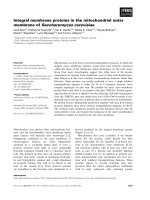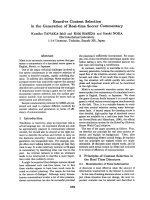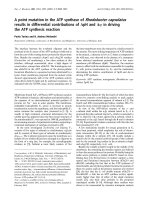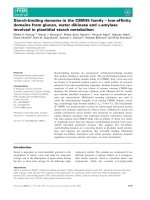Báo cáo khoa học: "Metabolism of isopentenyladenosine in the roots of Norway spruce seedlings exposed to nutritive stress" pdf
Bạn đang xem bản rút gọn của tài liệu. Xem và tải ngay bản đầy đủ của tài liệu tại đây (478.64 KB, 9 trang )
Original
article
Metabolism
of
isopentenyladenosine
in
the
roots
of
Norway
spruce
seedlings
exposed
to
nutritive
stress
K
von
Schwartzenberg
M
Bonnet-Masimbert
P
Doumas
INRA,
Centre
de
Recherche
Orléans,
Station
d’Amélioration
des
Arbres
Forestiers,
45160 Ardon,
France
(Received
9
June
1993;
accepted
8
June
1994)
Summary —
Seedlings
of
Norway
spruce
(Picea
abies)
were
grown
on
a
low
nutrient
medium
containing
Al3+
ions
(0.8
mM,
stress)
and
a
rich
medium
that
was
suitable
for
spruce
and
lacked
Al3+
(control).
After
feeding
with
tritiated
isopentenyladenosine
via
the
roots,
the
metabolism
of
cytokinins
in
the
roots
of
stressed
and
control
plants
was
compared.
HPLC
radioactivity
profiles
of
root
extracts
showed
that
isopentenyladenosine
was
mainly
degraded
to
isopentenyladenine-
and
adenine/adenosine-like
com-
pounds.
Stressed
and
non-stressed
seedlings
clearly
differed
with
respect
to
the
distribution
of
radioac-
tivity
for
the
different
metabolites.
The
measurements
showed
that
the
degradation
of
isopentenyl-
adenosine
was
strongly
reduced
in
the
roots
of
the
stressed
seedlings.
Results
are
discussed
with
regard
to
the
levels
of
endogenous
cytokinins
measured
in
spruce
affected
by
the
novel
type
of
forest decline.
Picea
abies
/ cytokinin
/ metabolism
/ radiolabelled
cytokinin
/ forest
decline
Résumé —
Métabolisme
de
l’isopentényladénosine
dans
les
racines
d’épicéa
soumis
à
un
stress
nutritif.
De
jeunes
plantules
d’épicéa
(Picea abies)
ont été
plantés
sur un
milieu pauvre
conte-
nant
des
ions
Al3+
(0,8
mM,
stress)
et
sur
un
milieu
sans
Al3+
bien
fourni
en
nutriments
(témoin).
Après
marquage
avec
de
l’isopentényladénosine
tritiée,
via
les
racines,
le
métabolisme
des
cytokinines
dans
les
racines
a
été
comparé
chez
les
plants
témoins
et
chez
les
plants
stressés.
Les
profils
de
radioactivité,
obtenus
après
HPLC,
à
partir
des
extraits
racinaires,
montrent
que
l’isopentényladéno-
sine
est
principalement
dégradé
en
isopentényladénosine
et
adénine
ou
adénosine.
Les
plantules
*
Correspondence
and
reprints
t
Present
address:
INRA,
Centre
de
Recherche
de
Versailles,
Laboratoire
de
Biologie
Cellulaire,
78026
Versailles,
France
Ade:
adenine;
Ado:
adenosine;
AMP:
adenosine
5’-monophosphate;
BLF:
synthetic
soil
solution
(from
German:
Bodenlösung
Fichte);
Ck(s)
cytokinin(s);
iP:
isopentenyladenine;
[9R]iP:
isopentenyladeno-
sine;
Z:
zeatin;
[9R]Z:
zeatin
riboside.
stressées
et
non
stressées
diffèrent
clairement
dans
leur
distribution
radioactive
pour
les
différents
méta-
bolites.
Les
marquages
montrent
que
la
dégradation
de
l’isopentényladénosine
est
fortement
retardée
dans
les
racines
des
plantules
stressées.
Les
résultats
sont
discutés
en
fonction
des
cytokinines
endogènes
chez
l’épicéa,
affecté
par
le
nouveau
type
de
dépérissement
des
forêts.
Picea abies
/ cytokinine
/ métabolisme
/
cytokinine
radiomarquée
/
dépérissement
des
forêts
INTRODUCTION
In
previous
work
it
has
been
shown
that
Norway
spruce
trees
affected
by
the
novel
type
of
forest
decline
in
Germany
exhibit
large
increases
in
the
content
of
the
endoge-
nous
cytokinin
ribosides,
zeatin
riboside
([9R]Z)
and
isopentenyladenosine
[9R]iP)
(Schwartzenberg
and
Hahn,
1991).
In
trees
that
show
specific
yellowing
of
older
needles
the
cytokinin
(Ck)
concentrations
were
clearly
positively
correlated
to
the
extent
of
tree
damage.
The
concentrations
of
the
free
Ck
bases
(zeatin
(Z)
and
isopentenylade-
nine
(iP))
also
tended
to
be
higher
in
needles
of
damaged
trees.
Results
from
fertilisation
experiments
car-
ried
out
at
the
Hils-site
(Weserbergland,
Germany)
and
experiments
performed
with
spruce
seedlings
grown
in
hydroculture
revealed
that
unfavourable
conditions
(nutri-
ent
shortage,
low
pH,
or
Al
ions)
can
induce
an
increase
of
Ck
ribosides
in
the
upper
part
of
the
trees
(Schwartzenberg,
1989).
To
date
it
is
not
clear
which
metabolic
pro-
cesses
are
responsible
for
this
accumula-
tion
of
Ck
ribosides
in
stressed
spruce
trees.
Many
investigations
have
shown
that
exogenously
supplied
Cks
are
actively
metabolised
by
plant
tissue
(Letham
and
Palni,
1983;
McGaw,
1986).
Cks
appear
to
be
metabolised
rapidly
into
the
nucleotide
forms
and
can
be
further
converted
into
nucleosides
and
free
bases.
Nucleotides,
nucleosides
and
free
bases
are
intercon-
vertible
and
this
interconversion
is
mostly
caused
by
enzymatic
systems,
which
also
have
adenine
(Ade),
adenosine
(Ado)
and
adenosine
5’-monophosphate
(AMP)
as
substrates.
It
is
as
yet
uncertain
whether
Ck-specific
enzymes
are
also
involved
in
the
interconversion
of
Cks
(Letham
and
Palni,
1983;
McGaw,
1986).
The
aim
of
this
work
is
to
investigate
how
far
the
metabolism
of
Cks
in
spruce
roots
becomes
modified
under
unfavourable
con-
ditions.
The
metabolism
of
radiolabelled
isopentenyladenosine
([9R][
3
H]iP)
in
spruce
seedlings
stressed
by
nutrient
shortage
and
phytotoxic
Al3+
ions
is
compared
with
that
of
non-stressed
plants.
MATERIALS
AND
METHODS
Plant
material
and
culture
conditions
Seeds
of
Norway
spruce
(Picea
abies
L
Karst)
were
obtained
from
Staatliches
Forstamt
Nagold
(Nagold,
Baden-Württemberg,
Germany);
origin
84008,
year
of
ripening
1990.
The
seeds
were
germinated
at
25°C
on
wetted
filter
paper.
After
germination
the
young
seedlings
were
transferred
to
a
hydroponic
culture
system
using
perlite
(Caahmro,
France)
as
a
substrate.
For
the
first
4
weeks
after
germination
the
per-
lite
was
wetted
with
Ingestad
medium:
CaCl
2
1
mM;
FeCl
3
0.018
mM;
MgSO
4
0.61
mM;
MnSO
4
0.3
μM;
NaCl
0.205
mM;
NH
4
NO
3
1.77
mM;
KCI
0.95
mM;
K2
HPO
4
0.32
mM;
CuSO
4
0.32
μM;
H3
BO
3
16
μM;
Na
2
MoO
4
0.033
μM;
ZnSO
4
0.63
μM; pH
3.8.
At
the
end
of
the
4th
week,
half of
the
seedlings
were
transferred
to
a
synthetic
soil
solu-
tion
(BLF)
medium
(stress
treatment):
NH
4
HSO
4
0.238
mM;
NaNO
3
0.099
mM;
KNO
3
0.123
mM;
NH
4
NO
3
0.0762
mM;
FeSO
4
0.0197
mM;
MgSO
4
0.04
mM;
MnSO
4
0.236
mM;
CaCl
2
0.14
mM;
K2
HPO
4
0.0161
mM;
H2
SO
4
0.12
mM;
H3
BO
3
0.0139
mM;
ZnSO
4
9.96
μM;
CuSO
4
0.016
μm;
Na
2
MoO
4
0.165
μM;
KI
0.722
μM;
CoSO
4
0.019
MM; pH 3.8.
The
BLF
medium
mimics
the
nutrient
con-
centrations
found
in
a
declining
stand
of
Norway
spruce
in
Germany.
Al3+
ions,
which
represent
a
stress
factor
in
combination
with
soil
acidification
and
low
nutrient
supply,
were
added
to
the
BLF
medium
in
form
of
AlCl
3
(0.8
mM).
The
compo-
sition
of
the
nutrient
media
Ingestad
(control)
and
BLF
(stress)
was
taken
from
Junga
(1984).
The
nutrient
media
were
changed
weekly.
The
seedlings
were
cultivated
in
a
growth
chamber
at
20°C
with
light
80
μE
m
-2
s
-1
for
16
h
per
day.
Synthesis
of
tritiated
isopentenyladenosine
Tritiated
[9R]iP
was
obtained
after
alkylation
of
(2)
[3
H]
adenosine
with
4-bromo-2-methyl-2-
butene
as
described
by
Laloue
and
Fox
(1987).
The
radiochemical
purity
of
the
(2)-[
3
H]-isopen-
tenyladenosine
([9R][2-
3
H]iP)
as
determined
by
HPLC
and
liquid
scintillation
counting
was
found
to
be
98%;
the
specific
activity
was
18
Ci/mmol.
Feeding
with
tritiated
isopentenyladenosine
The
roots
of
the
27-week-old
seedlings
were
cleaned from
the
perlite
and
washed
3
times
with
sterile
water.
The
intact
seedlings
were
transferred
into
hydroculture
in
order
to
be
fed
with
the
[9R]iP
via
the
intact
roots
(2
seedlings
per
assay).
The
[9R][
3
H]iP
(34
000
Bq/seedling)
was
diluted
in
either
Ingestad
or
BLF
medium
(sterile).
The
feed-
ing
solution
(2
ml)
was
aerated
with
80
ml/min
air.
Seedlings
were
incubated
for
2,
6
and
24
h.
The
apparent
uptake
of
[9R]iP
was
followed
by
determining
the
radioactivity
in
50
μl
aliquots
of
the
feeding
solution.
Extraction
and
prepurification
of
cytokinins
After
feeding
with
[9R]iP,
the
roots
were
washed
with
water,
dipped
into
liquid
nitrogen
and
homo-
genized
with
a
pestle
and
mortar.
The
powder
was
incubated
for
15
h
in
Bieleski’s
reagent
(methanol/chloroform/formic
acid,
15:5:3,
v:v:v;
Bieleski,
1964) at -20°C.
The
Bieleski’s
reagent
was
evaporated
by
rotary
film
evaporation.
The
residue
was
extracted
with
80%
methanol
and
was
centrifuged
at
500
g.
The
pellet
was
reextracted
with
80%
methanol
and
discarded.
The
supernatant
was
filtered
(5
μm,
cellulose
acetate,
Sartorius)
and
was
passed
through
a
Sep-Pak
C18
cartridge
(Waters)
to
remove
lipophilic
compounds.
The
effluent
was
filtered
(0.45
μm,
polypropylene,
Sartorius)
and
was
concentrated
by
rotary
film
evaporation
prior
to
HPLC
separation.
HPLC
separation
and
detection
of radiolabelled
cytokinins
The
HPLC
separation
of
Cks
and
their
metabolites
was
performed
on
a
Beckmann
system
using
a
Merck
LiChrospher
100
RP
18
column
(250
x
4 mm).
The
solvents
were:
(1)
40
mM
acetic
acid
adjusted
to
pH
3.35
with
triethylamine;
and
(2)
100%
acetonitrile.
The
flow
rate
was
1.5
ml/min
and
the
acetonitrile
concentration
raised
from
0
to
100%
within
50
min
(for
gradient
see
fig
4A
insert).
The
HPLC
effluent
was
fractionated
(1.5
ml
per
fraction)
and
radioactivity
was
measured
by
liquid
scintillation
counting
(Beckmann,
LS
1801).
RESULTS
Morphological
characteristics
of seedlings
The
morphology
of
stressed
seedlings
grown
on
the
BLF
medium
differs
from
that
of
the
Ingestad
seedlings
(control).
The
stressed
seedlings
exhibited
a
lower
rate
of
shoot
growth,
tended
to
have
yellower
needles
and
brown
roots.
These
seedlings
produced
a
great
number
of
lateral
roots.
Further
char-
acteristics
of
the
BLF
seedlings
were
a
reduced
length
of
the
primary
root
and
an
increased
ratio
of
the
root
to
shoot
fresh
weight
(table I).
Uptake
and
distribution
of
radioactivity
in
Norway
spruce
seedlings
The
total
radioactivity
supplied
in
form
of
[9R][
3
H]iP
was
measured
by
liquid
scintil-
lation
counting
and
the
apparent
uptake
of
radioactivity
was
determined.
The
major
part
of
the
radioactivity
was
absorbed
during
the
first
2
h.
After
2
h
the
radioactivity
uptake
was
low
but
constant.
Within
6
h
about
73%
of
the
initial
radioactivity
was
incorporated
into
the
plants.
BLF
and
Ingestad seedlings
exhibited
only
small
differences
in
the
uptake
kinetics
(fig
1A).
Roots
and
shoots
were
extracted
for
Ck
analysis.
In
order
to
protect
Ck
nucleotides
from
endogenous
phosphatase
activities,
the
homogenized
root
material
was
incu-
bated
in
Bieleski’s
reagent
(Bieleski,
1964)
prior
to
the
extraction
with
80%
methanol.
Lipophilic
compounds
were
retained
by
solid
phase
extraction
(C18)
and
the
total
radioac-
tivity
in
the
purified
extract
was
determined
(fig
1B).
The
sum
of
total
radioactivity
detected
in
roots
and
shoots
was
found
to
be
much
less
than
the
radioactivity
that
was
apparently
taken
up
by
the
plants.
The
radioactivity
determined
in
the
Ck
extracts
decreased
over
the
course
of
incubation,
while
the
apparent
uptake
of
radioactivity
increased.
This
suggests
that
the
[9R]iP
taken
up
was
converted
into
non-extractable
forms
(fig
1).
Figure
2
shows
a
comparison
of
the
total
radioactivity
measured
in
the
Ck
extracts
for
roots
versus
shoots.
The
major
part
of
the
tritiated
compounds
was
found
in
the
roots,
where
the
amount
of
extractable
radioactivity
was
initially
high
and
decreased
over
time.
However,
the
radioactivity
mea-
sured
in
the
shoot
extracts
was
very
low
throughout
the
entire
course
of
the
experi-
ment.
Only
for
the
Ingestad
seedlings
was
even
a
small
part
of
the
radioactivity
translocated
into
the
shoot
after
24
h. In
the
shoots
of
the
BLF
seedlings
no
increase
in
radioac-
tivity
was
observed
(fig
2).
HPLC
analysis
Root
extracts
from
the
[9R]iP
feeding
experi-
ments
were
submitted
to
HPLC
separation
and
the
radioactivity
in
the
effluent
was
ana-
lyzed
by
liquid
scintillation
counting
(fig
3).
The
radioactivity
peaks
separated
by
HPLC
cochromatographed
with
the
unlabelled
standard
substances
AMP,
Ade/Ado
(not
separated),
iP
and
[9R]iP.
Other
unidenti-
fied
peaks
were
detected
(retention
times
3-4
min
and
33
min).
In
roots
of
the
Ingestad
seedlings
(fig
3A-C)
only
a
minor
peak
of
[9R]iP,
which
was
used
for
the
feeding,
was
found.
How-
ever,
a
major
radioactivity
peak
coelutes
with
iP.
In
the
roots
of
the
BLF
seedlings
(fig
3D-F)
the
distribution
of
the
radiolabelled
metabolites
was
clearly
different
from
that
found
in
the
Ingestad
plants.
The
main
dif-
ference
was
the
reduced
metabolism
of
[9R]iP.
In
roots
of
BLF
seedlings,
[9R]iP
was
found
as
a
major
tritiated
compound
up
to
24
h
after
the
start
of
feeding
and
its
metabolite
iP
was
only
found
in
minor
quan-
tities
(figs
3
and
4).
Interestingly,
the
roots
of
Ingestad
and
BLF
seedling
did
not
show
any
significant
radioactivity
detectable
at
the
elution
times
for
the
hydroxylated
Cks
Z
and
[9R]Z
(fig
3).
DISCUSSION
Nutritive
stress,
including
soil
acidification,
nutrient
shortage
and
phytotoxic
aluminium
ions
(Al
3+),
have
been
suggested
to
be
an
important
factor
causing
the
phenomenon
of
the
novel
type
of
forest
decline
(Ulrich,
1983;
Godbold
et al,
1988;
Klein
and
Perkins,
1988).
In
order
to
study
possible
effects
of
nutritive
stress
upon
Ck
metabolism
in
spruce,
a
low
nutrient
medium
(BLF),
which
mimics
the
soil
solu-
tion
of
an
acidified,
declining
Norway
spruce
stand,
was
used
to
stress
seedlings
under
laboratory
conditions.
Al
ions,
which
can
be
considered
as
a
stress
factor
in
acidified,
low
nutrient
soils,
were
added
to
the
BLF
medium.
It
is
known
that
Al
ions
can
disturb
plant
nutrition
by
inhibition
of
Ca
and
Mg
uptake
(Jorns
and
Hecht-Buch-
holz,
1985).
What
is
important
for
the
root
damage,
is
not
the
absolute
Al
concentra-
tion
but
the
molar
ratio
of
the
Ca
and
Mg
ion
concentrations
to
that
of
the
Al
ions.
With
a
Ca/Al
ratio
of
0.77
and
a
Mg/Al
ratio
of
0.05,
spruce
roots
meet
a
considerable
Al
stress
in
the
BLF
medium
(Rost-Siebert,
1983).
The
characteristics
observed
for
the
stressed
BLF
seedlings,
such
as
enhanced
formation
of
lateral
roots,
reduction
of
shoot
growth
and
the
yellowing
needles
of
the
stress-treated
plants,
are
similar
to
proper-
ties
of
Al-treated
spruce
plants
as
described
by
Junga
(1984)
and
Jorns
and
Hecht-Buch-
holz (1985).
During
feeding
with
[9R][
3
H]iP,
the
uptake
kinetics
and
distribution
of
total
radioactivity
of
the
stressed
and
control
seedlings
were
found
to
be
very
similar.
For
both
types
of
seedlings,
it
is
remarkable
that
less
than
28%
of
the
radioactivity
taken
up
could
be
detected
in
the
Ck
extract.
Apparently
a
large
part
of
the
radioactivity
had
been
converted
to
forms
that
are
not
extractable
by
the
extraction/purification
protocol
used.
A
pos-
sible
explanation
could
be
that
after
degra-
dation
of
Cks
to
adenine-like
compounds
by
Ck-oxidase
(fig
3),
most
of
the
radioactivity
had
been
incorporated
into
the
fraction
of
nucleic
acids,
which
was
not
analysed.
During
the
entire
feeding
experiment
(24
h),
the
seedlings
absorbed
about
200
μl liquid,
which
should
have
allowed
a
cer-
tain
amount
of
radioactivity
to
be
translo-
cated
into
the
upper
parts
of
the
seedlings,
but
very
little
extractable
radioactivity
was
detected
in
the
shoots
(fig
2).
The
contra-
dictory
slopes
of
the
radioactivity
curves
in
roots
and
shoots
indicate
that
losses
of
sol-
uble
radioactivity
in
the
roots
are
only
to
a
very
limited
extent
due
to
transport
into
the
shoot.
This
means
that
a
very
active
metabolism
of
the
[9R]iP
takes
place
in
the
roots.
The
HPLC
radioactivity
profiles
confirm
a
rapid
metabolism
of
[9R]iP
in
spruce
roots.
Although
similar
patterns
of
radiolabelled
metabolites
were
detected
in
stressed
and
control
plants,
their
quantitative
distribution
differs
to
a
large
extent
(figs
3
and
4).
A
main
effect
of
the
stress
treatment
is
that
the
metabolism
of
the
[9R]iP
is
obviously
retarded.
After
2
h
feeding,
about
18%
of
the
incorporated
radioactivity
in
stressed
seedlings
was
found
in
the
[9R]iP
fraction
and
2.1
%
in
the
iP
fraction
compared
to
4.4
and
8.5%
in
the
Ingestad
seedlings,
respec-
tively.
Despite
the
fact
that
the
iP-type
Cks
are
considered
as
precursors
for
the
zeatin-type
Cks
(Letham
and
Palni,
1983)
no
significant
amount
of
radioactivity
was
found
for
these
hydroxylated
forms.
However,
immuno-
enzymatic
analysis
of
endogenous
Cks
has
shown
that
zeatin-type
Cks
are
present
in
the
roots
of
spruce
seedlings
(Schwartzen-
berg
et al,
unpublished
data).
It
can
be
assumed
that
either
roots
of
spruce
seedlings
are
not
the
primary
sites
for
the
hydroxylation
of
iP-forms
to
give
the
zeatin-
forms
or
this
hydroxylation
is
very
slow.
However,
it
should
be
taken
into
consider-
ation
that
the
metabolism
of
exogenously
supplied
Cks
might
differ
from
that
of
endogenous
Cks.
The
tritiated
[9R]iP
and
its
metabolites
might
have a different
distri-
bution
in
the
cellular
compartments
in
com-
parison
to
the
endogenous
forms.
Today
it
is
widely
accepted
that
roots
are
the
main
sites
for
Ck
biosynthesis
(Skeene,
1975;
Torrey, 1976).
Furthermore,
in
the
conifer
species
Pseudotsuga
menziesii
it
has
been
shown
that
Cks
are
transported
in
the
xylem
fluid
(Doumas
and
Zaerr,
1988).
Considering
our
results
concerning
the
concentration
of
endogenous
CKs,
we
might
assume
that,
in
the
roots
of
the
stressed
BLF
plants,
the
enzymatic
activities
regu-
lating
Ck
metabolism
promote
a
high
level
of
Ck
ribosides
in
comparison
to
control
plants.
When
the
endogenous
Ck
content
was
measured
by
means
of
immunotitration,
the
BLF
seedlings
showed
an
increase
of
[9R]iP
and
[9R]Z
compared
with
the
Ingestad
plants.
However,
this
increase
of
Ck
ribo-
sides
was
only
strongly
expressed
for
the
shoots
and
less
pronounced
for
the
roots
of
the
seedlings
(Schwartzenberg,
1989;
Schwartzenberg,
unpublished
data).
The
picture
of
the
regulation
of
endoge-
nous
Ck
content
remains
incomplete
as
no
data
on
Ck
biosynthesis
in
spruce
roots
are
available
at
present.
Attempts
to
measure
Ck
biosynthesis
(in
spruce
seedlings)
by
feeding
large
quantities
of
[3
H]adenine
for
24
h
via
the
roots
revealed
no
considerable
radioactivity
in
the
fractions
of
the
Cks
E,
[9R]Z,
iP
and
[9R]iP
(data
not
presented).
With
regard
to
the
previous
measure-
ments
carried
out
in
Germany
on
trees
of
forest
stands
with
different
degrees
of
dam-
age,
we
think
that
unfavourable
soil
condi-
tions
could
lead
to
a
reduction
of
Ck
ribo-
side
metabolism
and
thus
change
the
cytokinin
status
of
the
trees
(Schwartzen-
berg
and
Hahn,
1991).
However,
a
direct
comparison
between
the
spruce
trees
from
forest
stands
and
the
model
system
pre-
sented
in
this
paper
is
not
possible
as
plant
material
and
growth
conditions
are
too
dif-
ferent.
The
presence
of
mycorrhiza
in
the
spruce
from
the
forest
stands
may
be
seen
as
the
main
difference
to
the
seedlings
used
in
this
work.
It
seems
likely
that
microor-
ganisms
associated
with
spruce
roots,
espe-
cially
mycorrhizal
fungi,
have
an
influence
on
cytokinin
status
of
the
plants
as
they
are
capable
of
producing
cytokinins
and
other
plant
hormones
(Miller,
1966;
Gogola,
1991;
Kraigher et al,
1991).
There
is
also
some
evidence
that
microorganisms
can
interfere
with
the
cytokinin
metabolism
of
spruce
roots.
After
incubation
with
[9R]iP
or
[9R]Z,
we
recently
detected
unknown
Ck
metabolites
in
the
nutrient
solution
of
spruce
roots
(Schwartzenberg
et
al,
1994).
These
metabolites
were
absent
if
sterile
in
vitro
grown
seedlings
were
used
for
incubation.
For
further
work,
we
propose
the
study
of
Ck
metabolism
in
sterile
roots
and
in
roots
infected
with
microorganisms
(mycorhizal
fungi
and/or
soil
bacteria).
This
seems
important
in
order
to
show
whether
the
delayed
metabolism
of
Ck
ribosides
in
the
roots
can
cause
an
accumulation
of
[9R]iP
and
[9R]Z
in
needles
or
shoots,
as
has
been
found
for
spruce
affected
by
the
novel
type
of
forest
decline.
ACKNOWLEDGMENTS
KvS
thanks
the
Eurosilva
tree
research
cooper-
ation
for
a
postdoctoral
fellowship.
The
authors
thank
M
Laloue
(INRA,
Versailles)
for
his
support
in
preparing
the
[9R][
3
H]iP
and
for
helpful
discussions.
The
authors
further
thank
B
Moffatt
for
critical
revision
of
the
manuscript.
REFERENCES
Bieleski
RL
(1964)
The
problem
of
halting
enzyme
action
when
extracting
plant
tissues.
Anal
Biochem
9, 431-
442
Doumas
P,
Zaerr JB
(1988)
Seasonal
changes
in
levels
of
cytokinin-like
compounds
from
Douglas
fir
xylem
extrudate.
Tree Physiol 4,
1-8
Godbold
DL,
Fritz
E,
Hüttermann
A
(1988)
Aluminium
toxicity
and
forest
decline.
Proc
Natl
Acad
Sci
USA
85, 3888-3892
Gogola
N
(1991)
Regulation
of
mycorrhizal
infection
by
hormonal
factors
produced
by
hosts
and
fungi.
Expe-
rientia 47,
331-340
Jorns
A,
Hecht-Buchholz
C
(1985)
Aluminiuminduzierter
Magnesium-
und
Calciummangel
im
Laborversuch
bei
Fichtensämlingen.
Allg Forstzeitschrift 46,
1248-
1252
Junga
U
(1984)
Sterilkultur
als
Modellsystem
zur
Unter-
suchung
des
Mechanismus
der
Aluminium-Toxizität
bei
Fichtenkeimlingen.
Berichte
des
Forschungszen-
trums
Waldökosysteme
und
Waldsterben,
Reihe
B,
Bd,
5 Universität
Göttingen,
Germany
Klein
RM,
Perkins
TD
(1988)
Primary
and
secondary
causes
and
consequences
of
contempory
forest
decline.
Bot Rev 54,
1-1-43
Kraigher
H,
Grayling
A,
Wang
TL,
Hanke
DE
(1991)
Cytokinin
production
by
two
ectomycorrhizal
fungi
in
liquid
culture.
Phytochemistry 30,
2249-2254
Laloue
M,
Fox
JE
(1987)
The
synthesis
of
tritiated
ribo-
sylzeatin
with
high
specific
activity.
Phytochemistry
26, 987-989
Letham
DS,
Palni
LMS
(1983)
The
biosynthesis
and
metabolism
of
cytokinins.
Ann Rev
Plant
Physiol 34,
163-197
McGaw
BA
(1986)
Cytokinin
biosynthesis
and
metabolism.
In:
Plant
Hormones
and
their
Role
in
Plant
Growth
and
Development
(PJ
Davies,
ed),
Dordrecht,
The
Netherlands,
76-93
Miller
CO
(1966)
Zeatin
and
zeatin
riboside
from
a
myco-
rrhizal
fungus.
Science
157, 1055-1557
Rost-Siebert
K
(1983)
Aluminium-Toxizität
und
-Toleranz
an
Keimpflanzen
von
Fichte
(Picea
abies
Karst)
und
Buche
(Fagus
sylvatica
L).
Allg
Forstzeitschrift 26/27,
686-689
Schwartzenberg
v
K
(1989)
Der
Cytokiningehalt
in
Nadeln
unterschiedlich
stark
von
’neuartigen
Wald-
schäden’
betroffener
Fichten
(Picea
abies
(L)
Karst)
bestimmt
mittels
einer
immunoenzymatischen
Meth-
ode -
ELISA.
PhD
thesis,
University
of
Bonn,
Ger-
many
Schwartzenberg
v K,
Hahn
H
(1991)
The
cytokinin
con-
tent
in
needles
of
Norway
spruce
(Picea
abies
(L)
Karst)
with
different
degree
of
damage.
J
Plant
Phys-
iol 139, 218-223
Schwartzenberg
v
K,
Bonnet-Masimbert
M,
Doumas
P
(1994)
Isolation
of
two
cytokinin
metabolites
from
the
rhizosphere
of
Norway
spruce
seedlings
(Picea
abies
(L)
Karst).
Plant
Growth
Regulation
15,
117-
124
Skene
KGM
(1975)
Cytokinin
production
by
roots
as
a
factor
in
the
control
of
plant
growth.
In:
The
Devel-
opment
and
Function
of
Roots
(JG
Torrey,
DT
Clarkson,
eds)
Academic
Press,
London,
UK,
365-
396
Torrey
JG
(1976)
Root
hormones
and
plant
growth.
Ann
Rev
Plant
Physiol 27,
435-459
Ulrich
B
(1983)
Stabilität
von
Waldökosystemen
unter
dem
Einfluss
des
"sauren
Regens".
Allg
Forstzeitschrift
26/27,
668-677









